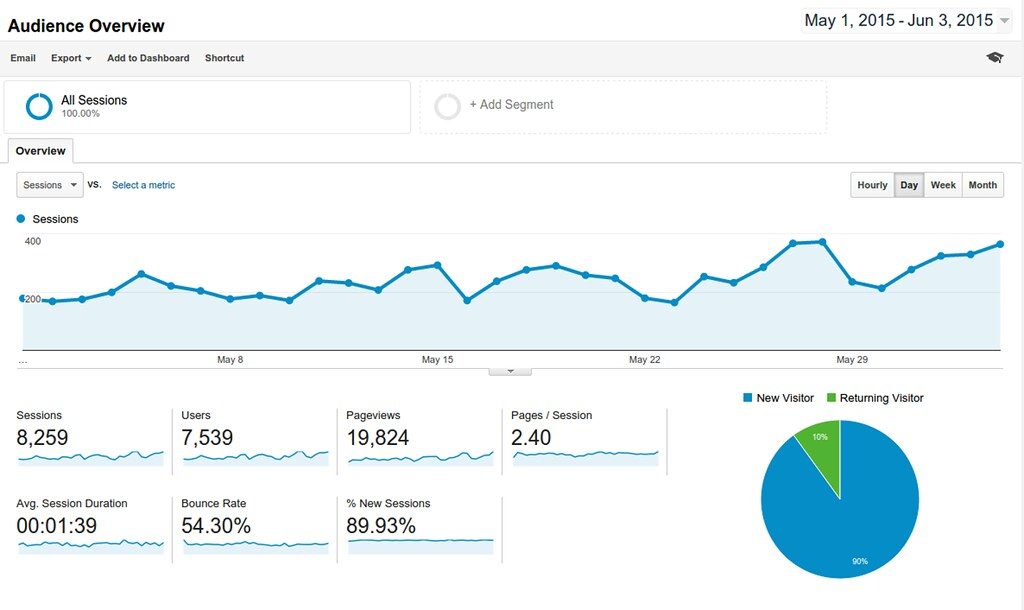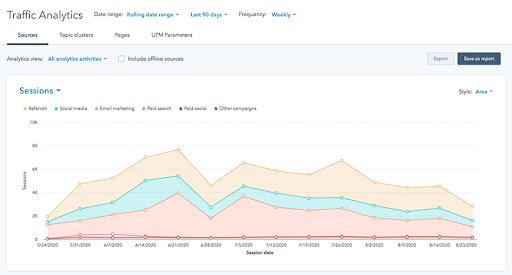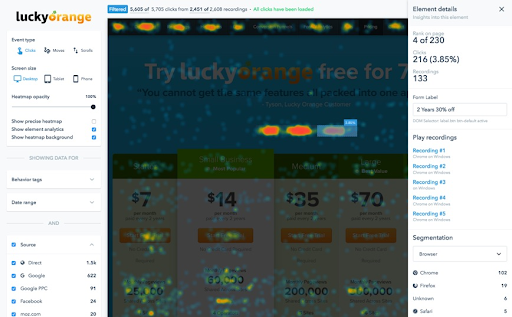Topics:
Web DesignJoin 40,000+ sales and marketing pros who receive our weekly newsletter.
Get the most relevant, actionable digital sales and marketing insights you need to make smarter decisions faster... all in under five minutes.
Business website problems
- You don't have the data tools to know how your website is performing
- Your visitors are abandoning your website (high bounce rate)
- Your ideal buyers hate your website because your website copy is all about you
- Your users don't like your current content strategy (it's not them, it's you)
- You have low organic search traffic, which means you're not getting found online
- Your website isn't ADA compliant
- You're not generating leads from your website (even if you're generating traffic)
- You struggle to update your website without IT experts or web developers
Which of these costly business website mistakes are you guilty of?
Your business website should be your #1 sales rep, driving qualified traffic, leads, and sales for your company.
But what if your website isn’t doing that? What do you do if you can feel something is wrong with your company website, but you don’t know what specifically? Stick around, because that’s exactly what we’re going to talk about in this video.
Now, let's dig deeper into each specific business website problem...
Let's talk about your business website. You know the old saying that your website is supposed to be your salesperson that never sleeps, blah, blah, blah.
To be clear, I'm not "blah, blah, blah"-ing it because it's untrue. It's more that when you hear a statement so often, it transforms quickly into a clichéd fortune cookie phrase, and you can forget how important and true that statement actually is.
🔎 Related: Ultimate website redesign guide for businesses
It's kind of like when I tell my cat "I love you SO much," as I squish her face for the thousandth time in a single morning, and I just know she's taking my love for granted while also thinking, "Good gravy, woman, will you just feed me already?!"
So, let's be clear about what I'm saying when your website should be your top salesperson who never sleeps — or, more specifically, what it looks like when your website is falling short of this goal:
- If your website isn't working, you'll have massive traffic issues. For example, you'll attract no traffic. Or you'll attract traffic, but unqualified traffic. And by "unqualified," I mean people who will never, ever give you money for any products or services that you sell.
- If your website isn't working, your lead flow will be slim to none. Maybe you don't give them enough conversion opportunities. Maybe your content strategy is really the culprit. It could be a lot of things.
- Finally, if your website is broken, your sales team will go hungry. Without qualified traffic or leads coming in, what will they feast on? No one wants that. That's how businesses die, right?
What's tricky is that often you'll see all or some of these symptoms of a broken website. However, it may be a bit trickier to diagnose the actual problem, so you know how to take action.
Well, have no fear — that's why I am here today.
We're going to walk through the six top signs your website is truly broken, as well as what specific actions you need to take to get your website humming along like revenue-generating machine it should be.
1. You don't know how your website is performing
We're starting with this one because, holy cannoli, if you don't even know if your business website is healthy or not — like you can't even answer the question of whether or not your website is broken or doing exactly what it should be doing for your business — yikes.
What do I mean when I say you "don't know" how it's performing? Well, let's break this down into a few questions that you should be able to answer, or know that you can at least get the answer:
- Do you know how much website traffic you have?
- Do you know where that traffic is coming from?
- Do you know where visitors tend to abandon your website?
- Do you know your most trafficked pages?
- Do you know your least trafficked pages?
- Do you know how many new visitors you're getting?
- Do you know how many returning visitors you're getting?
If the answer to these questions is yes, you may proceed to the next item in this list. (You're awesome.)
If you're currently staring saucer-eyed at your computer screen wondering what the heck I'm even talking about or feeling slightly panicked that you don't know how or where to get this information, you're also awesome. But let's talk about how you fix it.
Get Google Analytics

Google Analytics provides details about your web traffic. The insights you can glean from Google Analytics include (but are not limited to) the geographic location of your users, their device type, the pages visited, time spent on page, referring pages, their original source, and more.
🔎 Related: How to build your first Google Analytics report
Get HubSpot

What is HubSpot? Well, that answer was much simpler a few years ago, but so much has changed since then. HubSpot started as a marketing automation platform, but now it also provides sales and service solutions, along with a business website-building platform.
🔎 Related resources:
- Is HubSpot Marketing Hub right for your company?
- HubSpot CRM vs Salesforce: Which one is right for you?
- Everything you need to know about the HubSpot CMS Hub for websites
I cannot even begin enumerate the endless benefits of using an all-in-one marketing, sales, service, and website platform like HubSpot.
Yes, you get all the amazing analytics like traffic, sources, conversions, and so on, but you'll also have the ability to pivot your strategy (as needed) in real-time because you don't need to waste time patch-working together data from different sources. It'll all be right at your fingertips, with no extra effort.
And don't even get me started how positively wild your ability to actually report how much money your content marketing is making for your company — yes, down to specific dollars and cents — when you have your marketing, sales, and website automation all talking to each other in one digital ecosystem.
In short, we're biased toward HubSpot because it truly is the full package.
2. Your visitors are bouncing (i.e., straight up abandoning) your website
OK, so let's say you now have Google Analytics and HubSpot and you see that (hooray!) you're attracting visitors to your website. But then you notice something bad. You have a high bounce rate, meaning someone is landing on your website and then not clicking through more deeply.
They're. Just. Leaving.
There are a lot of reasons why this could be happening:
- Your website copy is all about you, which is one of the top reasons why your ideal buyers hate your website.
- The only conversion opportunities you're providing are for those who are immediately to reach out to you for your products and services; you don't have anything for anyone is still in the education or consideration stage.
- Or maybe you have educational content but, sad trombone, it's too sales-y and a big ol' turnoff to ideal buyers who just feel like you're trying to take their money instead of answering their questions.
- The user flow on your website is confusing, where users are left to guess what they're supposed to do next. Maybe the layout is counter-intuitive. Maybe you named your services and site sections "clever" names. Who knows... either way, the moment you make someone think when it comes to what a user needs to do next on your site is the moment you've lost them completely.
Lucky for you, there are ways to fix these issues and more.
Users aren't clicking beyond your homepage or aren't taking the actions you expect them to
This is why website heat-mapping tools like LuckyOrange exist:

LuckyOrange shows you with literal heat-mapping how far users scroll on your website pages, what they click the most, what they click the least, and much, much more. I cannot advise you strongly enough to invest in a tool like this, especially if you're making changes to your website flow.
Here are a few simple ways to make sure your buyers love you and using your business website:
- Your website navigation menu is set up intuitively with clear, immediately understood labels and headings.
- The click-through and conversion pathways you want someone to take to go more deeply into your website (e.g., homepage to service pages) are strategically scoped and placed.
- Your website design is responsive, so the experience your users have is absolutely rockstar no matter whether they're on a desktop, a laptop, their phone, or a tablet.
- Overall, your website page designs follow best practices for layout, design, and copywriting.
Want to learn more? We've got you covered:
- 30 Eye-Opening User Experience Stats [Infographic]
- User Experience Design: 4 Essential Elements & Awesome Resources to Save
- 5 Places to Get Website UX and Design Feedback That's Actually Helpful
- The Business Value of UX Design [Infographic]
- How UX Goes Hand-in-Hand With SEO
- 9 Essential Principles for Designing a Flawless User Experience
- 11 tried and true laws of UX [Infographic]
Your users don't like your current content (meaning it's not them, it's you)
The content that attracts the right buyers, no matter what industry you're in, all share the same attributes:
- The best content focuses with laser-like precision on the most pressing questions, worries, fears, and problems your ideal buyers have.
- The best content then answers those questions thoroughly and honestly, no matter how uncomfortable it may feel to do so. (For example, y'all gotta talk about cost. Resistance is futile.)
- The best content is written for your ideal buyer, with no hidden agendas or poorly executed sales attempts slipped in.
- Finally, the best content builds trust. Trust is the most true currency for any business, and without trust, you'll never see the digital sales and marketing growth you're looking for. Period. Full stop.
So, if your content instead...
- Is focused with laser-like precision around your needs and priorities.
- Only addresses safe questions without going too deeply into answers where things get seemingly "dicey" or where you're worried about scaring people away with the honest answer(s).
- Is written for you to achieve your goals, with sales pitches built-in, regardless as to whether they're appropriate or not.
- Does not take into account the importance of building trust by positioning yourself as the most honest and thorough teacher out there about what it is that you do and/or sell.
...you've got a huge problem.
This is why even if you manage to drive the right traffic to you, it evaporates (for the most part) without those ideal buyers ever converting or digging deeper.
The good news is that you can fix this, and here's how:
- Evaluate your website critically and determine whether or not you've got a website problem or a content strategy problem. (Often, we've found it's the latter, even if it seems or feels like the former.)
- Build your written content strategy around the five best business blog topics that are guaranteed to drive traffic, leads, and sales for any business, regardless of size or industry.
- Learn from world-class blog post examples from a wide range of industries to understand what great, educational, revenue-generating content looks like.
- Become epic content creators in your own right by understanding the specific process for how to write a blog post, as well as the principles you need to embrace to add personality to your content, so you become unforgettable.
By following those steps, you'll be well on your way to fixing your bad content problem in no time. Is it a lot of work? Yes. But you'll see better results and you'll actually start enjoying creating content.
3. Your organic search traffic volume leaves much to be desired
Unless you're a huge brand with universal recognition and affinity, there's a good chance the vast majority of your ideal buyers haven't heard of you yet.
That means in order to get in front of them with your amazing content so they can see how you are the absolute best solution to their problems will hinge upon your ability to get found online. More specifically, your ability to generate organic search traffic with your content.
So, if you're not generating that organic search traffic — meaning people are only getting to you if they already know of you, follow you, and so on — your website is doing you wrong.
But lackluster organic search traffic can be a symptom of a number of problems:
- Your content quality is poor, which we discussed at length in the last section. This matters, because search engines like Google rank content not only based on keyword optimization, but also on quality and relevance. So, if your content quality is bad, leading to a lot of visitors bouncing off of it quickly after clicking through, that sends a signal that your content shouldn't be ranked as highly.
- You publish new content infrequently, which is a problem because (once again) search engines like Google reward sites for freshness and new, frequently updated content.
- Your keyword optimization strategy isn't great, which means even if you publish great content frequently, no one will find it. You can solve this by making sure you're creating content for questions that are really being asked and then using tools like SEMrush to optimize the strategy for those content pieces and for finding new opportunities.
- Your site speed sucks, so you're shooting yourself in the foot. You can have amazing content with a rockstar optimization strategy and publishing cadence... but if your site speed sucks, Google is going to penalize you big time, since how quickly your site and individual pages load is a major ranking factor.
4. Your website isn't accessible
Hoo boy, accessibility is a live wire of an issue for businesses right now. Why? Well, we all agree that building a website that is accessibility to individuals of all abilities is what is not only essential, but also right and fair.
However, the United States legal system has yet to come to any sort of consensus on how responsible businesses are for making that happen, and to what degree. This murkiness in the letter of the law means website owners like you may be more open than you realize to lawsuits centered around this very issue.
Ambiguities aside, you need to do your best to make your website ADA compliant — as the Americans with Disabilities Act is the core of what drives website accessibility. If you're unsure as to whether or not your website currently is ADA compliant, you can use these testing tools:
Common ADA compliance recommendations include:
- Your fonts are large enough and easy to read.
- Clear contrast between text and background colors on website pages, taking into account those who may have color blindness.
- All images have alt text included for a description of what the image content includes, so those with vision impairments who use site readers can understand what all of the content on your website is. (Those readers will read the alt text of an image out loud, so "Screen Shot 2020-10-20" isn't going to work.)
- Your website is easy to navigate, with clear navigational cues of how to get around your site or on particularly dense pages.
🔎 Related resources:
- How is accessibility influencing the way IMPACT develops client websites? [Interview]
- Why Website Accessibility Is More Important Than Ever (& How to Do it Right)
- Website accessibility: Are you at risk for an ADA-compliance lawsuit in 2020?
- Like a Leo: 30th anniversary of ADA highlights website accessibility importance
5. You're not generating leads from your website
OK, so let's say you're cooking with gas. Your website is rocking and rolling, and you've been able to check off the items so far...
- You know exactly how your website is performing thanks to your investment in awesome tools like Google Analytics, HubSpot, and LuckyOrange.
- Your visitors aren't bouncing off of your website, because they're loving how easy to use and valuable your website is.
- The content you're creating is *chef's kiss* perfect, because it's valuable, thorough, honest, and targeting the precise questions and problems your ideal buyers have.
- You're seeing great organic traffic coming through because your content quality is spot on, as is the optimization strategy driving it.
- Your website is ADA compliant and accessible to users and ideal buyers of all abilities, because you're just that awesome.
...but you've still got one problem, and it's a really big one. You're not generating leads from your website.
There are a few reasons why this happens:
- You're ignoring top and middle of the funnel lead opportunities by only having a bottom of the funnel offer like "contact us" or "free demo/consultation" on your website. That's bad because that means you're letting potential buyers who are simply earlier in their journey walk out the virtual door, because they have no way to take action or engage with you until they're ready to make a deal.
Fix this by creating top and middle of the funnel offers with educational guides, downloadable pillar pages, checklists, templates, tools, and more. Then nurture those leads with email workflows, new content, and so on. - You've got offers for all parts of the funnel, but your landing pages are failing you. Your copy must be absolutely clear in exactly what the thing is that you're offering, why it's so stinkin' valuable, and exactly what will happen when your ideal buyers convert. I also cannot stress enough the importance of having a video on each of your landing pages, as they are proven to drastically increase leads generated for offers where they are present.
- You're asking for too much information on your forms. The amount of information you ask for should be reflective of (a) the value of the content you're giving, and (b) where someone is in their journey.
For example, if you have a top of the funnel e-book that's purely educational, asking for someone's email address and name (maybe even their role or job title) is OK. But also asking for their address, annual revenue as a company, phone number, and so on, is way, way too much.
🔎 Related: 42 landing page examples to inspire yours
Let's say, however, that you're doing those things. You've got lead magnet offers for all parts of the funnel and your landing pages are stellar. You also need to take the added step of attaching calls-to-action (CTAs) to relevant blog articles and website pages, so your potential leads actually find them in their travels.
In short, you can't make those offers hard to find.
6. You find it difficult to update your website on your own
In a perfect world, the very moment you need to update your website — due to a change in service or product offerings, the need to experiment with your conversion copywriting, a stroke of divine inspiration, or whatever — you should be able to do so without having to call in the IT or website developer calvary.
If you are reliant upon a third-party resource to make key updates to your website, you'll never be as agile as you should be as a business with an online presence.
To achieve this level of agility, where your ideas and necessities can be realities with little to no friction, requires you to have:
- A content management system (CMS) for your website that has easy-to-use, intuitive publishing tools. (HubSpot and WordPress are great examples of this.)
- A flexible website backend interface and infrastructure that doesn't require a ton of coding to make frontend changes. (Wix and Squarespace, although they have limitations, are great examples of website builders that are user friendly for updates.)
I know, this was... a lot, to say the least
List articles like this are a bit of a double-edged sword. On the one hand, they're illuminating, in that they show you what you can (and should) be doing, in great detail. On the other hand, it can also feel like a mountain of work, where you're not exactly sure where to start.
So, here's my suggestion to you — understand that, before you take actions of any kind, you need to diagnose what your actual website problems are first.
The worst thing you can do is make assumptions about what's really wrong based on what you think might be the cause of the symptoms you're experiencing with your website. Get the data you need and examine it closely so you understand what parts of the chain (traffic, leads, and/or sales) are broken.
And, for Pete's sake, reach out to professionals if you need help. Your website is beating heart of your digital strategy, so invest in it. Because, if you continue to neglect it or try to solve big problems with half-assed, band-aid solutions, it'll show in your result
Free: Assessment

